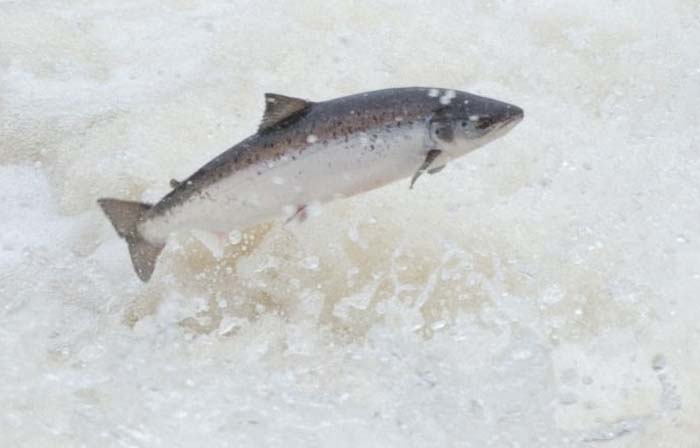
Wild Atlantic salmon numbers dropped 15 percent in 2017 compared to the year before. Photo credit Atlantic Salmon Federation.
Atlantic Salmon Federation: New Proof Salmon Farm Escapees Interbreed with Wild
By Leigh Anne Power / CBC NEWS – Newfoundland / Sept. 23, 2018
New proof that fish farm escapees interbreed with wild salmon. Researchers worry interbreeding diminishing Newfoundland’s wild salmon stocks.
[dropcap]F[/dropcap]or as long as there have been fish farms in this province, there have been fish escaping from cages into the wild. Conservationists have suspected those escapees breed with native fish, changing their DNA.
Now they say they have proof
One of the largest escapes in Newfoundland happened in 2013, when more than 20,000 salmon got away from a farm in Hermitage Bay. That incident inspired DFO scientists to study the genetic material of fish in salmon rivers on the island’s south coast.
“We looked at 19 rivers in the first year and hybrids were detected in 18 of those rivers,” said lead researcher, biologist Brendan Wringe.
More than 1/4 of river salmon are hybrids
“We weren’t surprised to find hybrids. We were surprised to find as many hybrids as we did and to find them as widely spread as we did. In total of the 17-hundred odd fish we sampled, about 27 per cent showed farmed origin. So they may have been hybrids or, more worryingly, feral fish. So that would be fish where both parents were of direct farm descent.”
Wringe said salmon interbreeding worries scientists because hybrid offspring may not be as able to survive as well as wild fish.
“Wild populations are adapted to local conditions: temperature, flow rate, pH [levels] are all important, whereas the farmed fish of course have been bred for fast growth in a closed environment,” he explained.
So interbreeding is likely to reduce the productivity of the wild populations because the hybrids are not as well adapted. We would expect that hybridisation will likely lead to general population decline. However we don’t have enough information to say what the magnitude of those declines could be.”
Steve Sutton, coordinator of community outreach and engagement with the Atlantic Salmon Federation, believes there is evidence interbreeding is hitting wild stocks hard.
“Well, we know that salmon on the south coast of Newfoundland have been assessed as threatened by the Committee on the Status of [Endangered] Wildlife in Canada,” he said.
Wild stocks dropping
“The only monitored population we have in the area where they’ve done the research is on the Conne River, which at one time had runs of eight or ten thousand fish. That’s been much lower than that for a long time, but in the last couple of years we’ve seen another huge drop in that population,” said Sutton.
“We’re down to less than a thousand the last two years and possibly less than 500 this year. So I think what we’re seeing the last two years are the impacts of this large interbreeding that occurred back in 2013.”
Sutton isn’t just worried about big escapes like the one in 2013. He’s concerned about the ones of fewer than a hundred farmed fish, which are not required to be reported.
“Well, there are some scientists who would suggest that those smaller escapes are probably actually worse than a single larger scale,” he said.
“The reason is, if you have a single large escape and you have interbreeding then the genetic material that’s introduced to the population will eventually weed itself out. It will have impacts as it does that because those fish that carry that material will be less likely to survive. So you will get lower numbers of adults but eventually it will weed itself out.”
“The problem is, if you have these smaller escapes that are ongoing, you’re actually getting a constant input of foreign genetic material into those populations and so the population never really gets a chance to recover.”
Regulators need to take action
Conservationists like Sutton say they don’t know whether salmon populations in which interbreeding has happened can ever return to their natural state.
Sutton said now that there’s proof there are significant numbers of hybrid fish in the wild, it’s time for the provincial government to tighten regulations to prevent future escapes.
In the meantime, researchers like Brendan Wringe will keep studying the problem.
“We are continuing to monitor the area as well as conducting ongoing studies and simulation studies to try and predict what potential impacts there might be,” he said.
They hope a better understanding of the effects of interbreeding will someday lead to better protection for wild salmon

